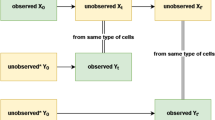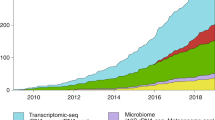Abstract
Rapid accumulation of biological data from novel high throughput technologies characteristic of genomic and proteomic research as well as advances in more traditional biological disciplines are leading to wider use of detailed and complex computational models of cell behavior. These models address a variety of dynamic intracellular processes ranging from interactions within a gene regulation network to intracellular and intercellular signal transduction. This review focuses on the current trends in computation cell biology, particularly emphasizing the role of experimental validation. The recent successes and future challenges facing computational cell biology are also discussed.
Similar content being viewed by others
References
Lotka AJ (1920) Undampted oscillations derived from the law of mass action. J. Amer. Chem. Soc. 42: 1595–1599
Volterra V (1926) Variazionie fluttuazioni del numero d'individui in specie animali conviventi. Mem. Acad. Lincei. 2: 31–113
Hodgkin AL & Huxley AF (1952) A quantitative description of membrane current and its application to conduction and excitation in nerve. J. Physiol. (Lond.) 117: 500–544
Eigen M (1971) Selforganization of matter and the evolution of biological macromolecules. Naturwissenschaften. 58: 465–523
Gierer A & Meinhardt H (1972) A theory of biological pattern formation. Kybernetik. 12: 30–39
Bhalla US & Iyengar R (1999) Emergent properties of networks of biological signaling pathways. Science. 283: 381–387
Fussenegger M, Bailey JE & Varner J (2000) A mathematical model of caspase function in apoptosis. Nat. Biotechnol. 18: 768–774
Levchenko A, Bruck J & Sternberg PW (2000) Scaffold proteins may biphasically affect the levels of mitogen-activated protein kinase signaling and reduce its threshold properties. Proc. Natl. Acad. Sci. USA. 97: 818–823
Therrien M, Michaud NR, Rubin GM & Morrison DK (1996) KSR modulates signal propagation within theMAPK cascade. Genes. Dev. 10: 2684–2695
Denouel-Galy A, Douville EM, Warne PH, Papin C, Laugier D, Calothy G, Downward J & Eychene A (1998) Murine Ksr interacts with MEK and inhibits Ras-induced transformation. Curr. Biol. 8: 46–55
von Dassow G, Meir E, Munro EM & Odell GM (2000) The segment polarity network is a robust developmental module. Nature. 406: 188–192
Endy D, You L, Yin J & Molineux IJ (2000) Computation, prediction, and experimental tests of fitness for bacteriophage T7 mutants with permuted genomes. Proc. Natl. Acad. Sci. USA. 97: 5375–5380
Huang CY & Ferrell JE (1996) Ultrasensitivity in the mitogenactivated protein kinase cascade. Proc. Natl. Acad. Sci. USA. 93: 10078–10083.
Ferrell JE & Machleder EM (1998) The biochemical basis of an all-or-none cell fate switch in Xenopus oocytes. Science 280: 895–898
Barkai N & Leibler S (1997) Robustness in simple biochemical networks. Nature 387: 913–917
Alon U, Surette MG, Barkai N & Leibler S (1999) Robustness in bacterial chemotaxis. Nature 397: 168–171
Bray D, Levin MD & Morton-Firth CJ (1998) Receptor clustering as a cellular mechanism to control sensitivity. Nature: 393: 85–88
Duke TA & Bray D (1999) Heightened sensitivity of a lattice of membrane receptors. Proc. Natl. Acad. Sci. USA. 96: 10104–10108
Shimizu TS, Le Novere N, Levin MD, Beavil AJ, Sutton BJ & Bray D (2000) Molecular model of a lattice of signalling proteins involved in bacterial chemotaxis. Nat. Cell Biol. 2: 792–796
McAdams HH & Arkin A (1997) Stochastic mechanisms in gene expression. Proc. Natl. Acad. Sci. USA. 94: 814–819
Arkin A, Ross J & McAdams HH (1998) Stochastic kinetic analysis of developmental pathway bifurcation in phage lambda-infected Escherichia coli cells. Genetics 149: 1633–1648
Gibson MA & Bruck J (2000) Efficient exact stochastic simulation of chemical systems with many species and many channels, J. Phys. Chem.A104: 1876–1889
Author information
Authors and Affiliations
Rights and permissions
About this article
Cite this article
Levchenko, A. Computational cell biology in the post-genomic era. Mol Biol Rep 28, 83–89 (2001). https://doi.org/10.1023/A:1017913813132
Issue Date:
DOI: https://doi.org/10.1023/A:1017913813132




